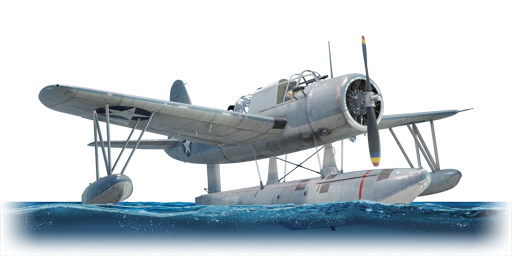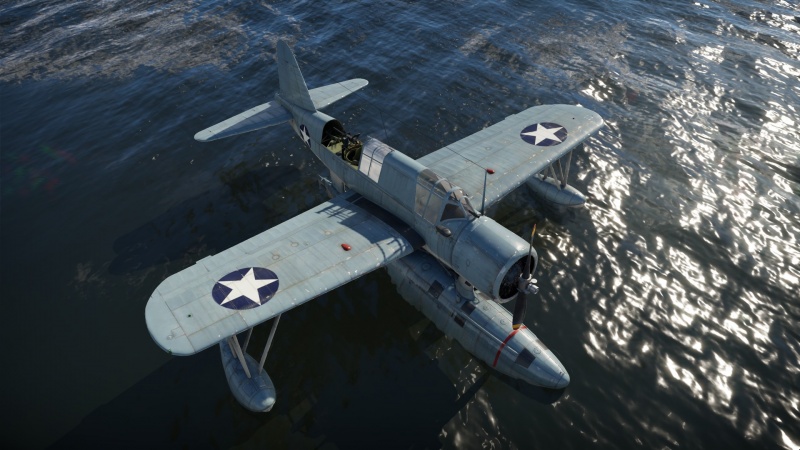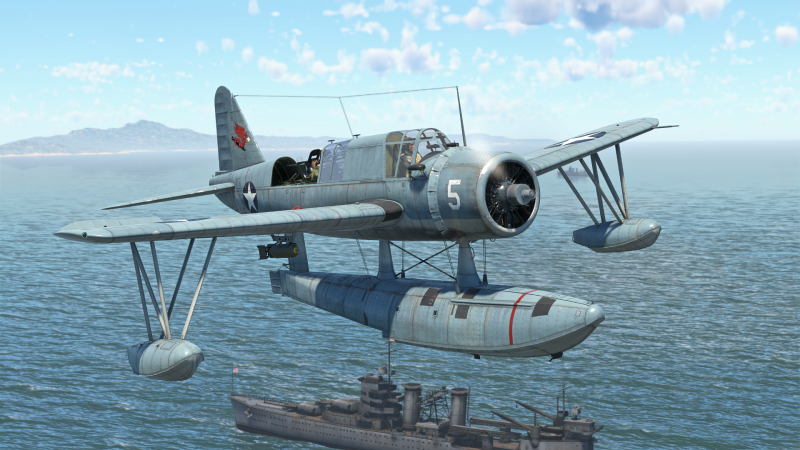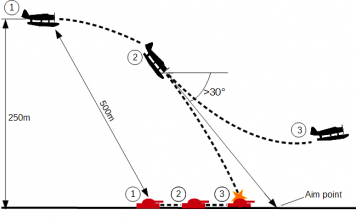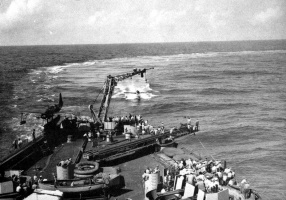OS2U-3
| This page is about the American hydroplane bomber OS2U-3. For the other version, see OS2U-1. |
Contents
Description
The OS2U-3 Kingfisher is the successor of the OS2U-1 and the OS2U-2, which was a version equipped with a regular landing gear. Compared to this previous versions, it uses a slightly different engine, the same Pratt & Whitney R-985-48 but with a different version, it also has increased range, thanks to the addition of two extra self sealing fuel tanks in the wings while also featuring improved armour for the pilot. The OS2U-3 was the most produced variant of the Kingfisher family with 1000 units built. This aircraft first flew in 1941 and it was the only exported variant of all the Kingfishers, it served in many countries from Uruguay to Australia including the Soviet Union aboard cruiser Murmansk (USS Milwaukee). The last Kingfishers were withdrawn from service in Cuba in 1959.
It has been in the game since the start of the Open Beta Test prior to Update 1.27, however, the vehicle was removed from the American air forces tree in Update 1.57 "Battle March". But was later added back to the tech tree during update 14.11.18. It can be researched by players who unlock the OS2U-1 via reaching rank II for the American naval tree. Much like its predecessor, the OS2U-3 is a mediocre plane for ground and air battles. With an armament consisting of only a single 7.62 mm MG for offensive actions and another for defence operated by a gunner, it is very vulnerable to other fighters, this is also exacerbated thanks to the mediocre flight performance. However it is very capable as a reconnaissance aircraft in naval battles, being capable of spotting targets from the distance, and then land in water if it is no longer necessary or if you are starting to be targeted by enemy AA guns. The increased ascend rate compared to the OS2U-1, means that it is better at reaching a comfortable altitude, which is imperative for success in Naval Battles.
General info
Flight performance
| Characteristics | Max Speed (km/h at 1,700 m) |
Max altitude (metres) |
Turn time (seconds) |
Rate of climb (metres/second) |
Take-off run (metres) | |||
|---|---|---|---|---|---|---|---|---|
| AB | RB | AB | RB | AB | RB | |||
| Stock | 280 | 269 | 6130 | 34.8 | 38.5 | 12.6 | 12.5 | 305 |
| Upgraded | 306 | 292 | 31.1 | 33.1 | 17.2 | 14.1 | ||
Details
| Features | ||||
|---|---|---|---|---|
| Combat flaps | Take-off flaps | Landing flaps | Air brakes | Arrestor gear |
| ✓ | ✓ | ✓ | X | X |
| Limits | ||||||
|---|---|---|---|---|---|---|
| Wings (km/h) | Gear (km/h) | Flaps (km/h) | Max Static G | |||
| Combat | Take-off | Landing | + | - | ||
| 405 | 350 | 337 | 308 | 160 | ~15 | ~15 |
| Optimal velocities (km/h) | |||
|---|---|---|---|
| Ailerons | Rudder | Elevators | Radiator |
| < 200 | < 200 | < 240 | > 306 |
| Compressor (RB/SB) | ||
|---|---|---|
| Setting 1 | ||
| Optimal altitude | 100% Engine power | WEP Engine power |
| 1,376 m | 400 hp | 450 hp |
Engine performance
| Engine | |||||
|---|---|---|---|---|---|
| Engine Name | Number present | ||||
| Pratt & Whitney R-985-48 9-cylinder | 1 | ||||
| Engine characteristics | |||||
| Weight (each) | Type | Cooling | |||
| 290 kg | Radial | Air | |||
| Engine power (Stock) | |||||
| Mode | Max | Take-off | |||
| Arcade | 364 hp | 415 hp | |||
| Realistic/Simulator | 360 hp | 411 hp | |||
| Engine power (Upgraded) | |||||
| Mode | Max | Take-off | |||
| Arcade | 446 hp | 496 hp | |||
| Realistic/Simulator | 400 hp | 450 hp | |||
| WEP Duration | |||
|---|---|---|---|
| Arcade | Realistic/Simulator | ||
| 25 seconds | Infinite | ||
Survivability and armour
- 6.35 mm steel behind pilot
- 8 mm steel behind gunner
- 8 mm steel on defensive 7.62 mm
- Self-sealing fuel tanks (1 in central fuselage, 1 in each wingroot)
Modifications and economy
Focus on performance and survivability upgrades: fuselage repair, radiator, compressor, engine, wings repair, airframe and cover. Weapons upgrades can be left for last. These will allow the use of more effective ammo belts.
Armaments
Offensive armament
The OS2U-3 is armed with:
- 1 x 7.62 mm Browning machine gun, nose-mounted (500 rpg)
Suspended armament
The OS2U-3 can be outfitted with the following ordnance:
- Without load
- 2 x 100 lb AN-M30A1 bombs (200 lb total)
Defensive armament
The OS2U-3 is defended by:
- 1 x 7.62 mm Browning machine gun, dorsal turret (600 rpg)
Usage in battles
The Kingfisher is classified as a bomber and as such it spawns at altitude. Primarily, it should be used in the ground attack role across all game modes. If possible, stay out of sight of the enemy and try to take indirect routes to desired targets. The single 7.62 mm gun is capable of destroying artillery, AAA (stationary and on trucks), landing craft, and armoured cars, but this is ill advised if an enemy aircraft is nearby. Tanks and light pillboxes cannot be destroyed with such a small MG calibre and will require bombs. Cargo ships will require a single 100 lb hit on deck.
Arcade battles
At the start of the battle dive to the side and let the team engage first enemy wave. Then when they are engaged in a fight and distract approaching enemy ground targets. As the main goal is to remain undetected as long as possible, always choose targets closer to the edge of the map.
When lower than the enemy it is harder for him to see the OS2U against the ground. Also, the enemy must approach much closer before the marker (name tag) shows up while at the same time his marker will show earlier. What distance will enemy's marker show up depends on weather conditions (clouds), altitude difference and pilot's skill.
If a more manoeuvrable enemy gets on the OS2U's six (any biplane and most of the monoplane fighters) and is unshakeable, try jerking, shaking and changing heading in random fashion while the gunner does his work. The Arcade flight model is more forgiving and will allow some aerobatics. This is especially viable if the enemy has only low calibre guns. Use this time to reach friendlies. Alternatively, get in the gunner's view and try to deal damage to the attacker.
Even though it has no wheels it can land on airfields but touchdown must be gentle and at low speed to avoid serious damage. After repairs, it will be spawned in the air. In "Domination" mode, where the goal is to seize enemy airfields by landing on them, Kingfisher can be used for capture but once landed it cannot take off immediately. This coupled with the dynamic nature of arcade battles usually leads to loss of the aircraft, therefore it is best to use it in last effort to turn the tide of the battle.
Realistic battles
This is where bomber spawn comes in handy. Dive to the side of the map and start approach to remote enemy ground targets. By doing so chance to be detected by the enemy is minimized even more so than in Arcade. Observe the sky and report any spotted enemies to the team.
In RB and SB modes flight model is realistic and the lack of powerful engine will be obvious. Thanks to its low Power to Mass ratio of about 0,13 kW/kg (P-26A Peashooter has 0,29 kW/kg) acceleration and climb rate are very poor. Energy retention is not Kingfisher's strong side either. Every hard turn will drain its energy and it will lose altitude rapidly. Attempts of performing any difficult manoeuvres, such as loop, are not advised before gaining some altitude and reaching decent speed (over 200 km/h IAS) otherwise the plane will stall out and plunge in the ground or become an easy target.
Since Kingfisher was never equipped with a bombsight there is no bombing reticle in RB. Another important thing is that in this mode both bombs will drop at the same time. Therefore, it is advised to try dive bombing. To hit a target climb a few hundred metres (250 m at least), line up with the target at least 1 km out to avoid lateral movement at final approach, when 500 m from the target start diving at an angle (30° or more – steeper the angle and higher the speed, less lead on target is needed), aim just above it, drop the load and pull out. Light tanks should be attacked from the back as it is easier to follow their movement. Try this in test flight before trying to pull it off in a battle.
Bombs can be set to explode not on impact, but with delay, too. This option makes ground attack safer since it gives the attacking aircraft more time to exit the blast radius. Kingfisher has a few things in its favour when performing dive attacks. First, low speed and low wing loading make pulling out close to the ground very easy. This means a higher chance of scoring a hit. Another thing is the small blast radius. While it requires high precision at the same time it lowers the chance to cause damage to the aircraft. If chosen to perform low bomb release 1-sec delay will give enough time to leave the blast radius and avoid damage.
When landing on water aircraft must be close to a carrier to repair. Approach it from the stern and stop at bow because most carriers will be moving and the plane needs to stand still during repair/reload.
Simulator battles
Aircraft's characteristics and advice mentioned in Realistic battles section apply to Simulator mode as well.
Cockpit visibility is decent but thanks to gunner's view this aircraft has excellent potential for situation awareness in simulator mode and this is what sets Kingfisher apart from the majority of its opponents. Zooming in while in the cockpit will activate telescopic sight which, while great for landing shots on distant targets, but may be slightly bothersome because it narrows the field of view.
Events
Once in a while under in-game Events & Tournaments tab there will be Floats event. It is Arcade event for float planes such as Kingfisher in which, among others, it will encounter H6K4, and PBY-5a. Stay away from their six because their gunners will shred Kingfisher to pieces in a matter of seconds. Wait for them to land in an attempt to capture zone, then drop 2 x 100 lbs on them.
Manual Engine Control
| MEC elements | ||||||
|---|---|---|---|---|---|---|
| Mixer | Pitch | Radiator | Supercharger | Turbocharger | ||
| Oil | Water | Type | ||||
| Not controllable | Controllable Auto control available |
Not controllable Not auto controlled |
Controllable Not auto controlled |
Combined | Not controllable 1 gear |
Not controllable |
Pros and cons
Pros:
- Bomber spawn
- Gets to participate in Floats event
- Can land on water
- Telescopic sight (RB)
- High minimum fuel load
- Center float can protect the plane from attacks from below
- You can ram other planes with the float (esp. the wings)
Cons:
- Low top speed
- Poor acceleration
- Poor climb rate
- Low power to mass ratio
- Small burst mass due to single 7.62 mm
- Poor energy retention
- No bombing reticle in RB, SB
- Telescopic sight (SB)
History
OS2U Kingfisher built by Vought-Sikorsky Aircraft Division was catapult-launched observation floatplane designed by Rex Beisel (a design engineer responsible for F4U Corsair). Kingfisher was assembled using a revolutionary spot welding construction which created a smooth fuselage that generated less drag. It also had numbers of innovative features, such as deflector plate flaps and drooping ailerons used to create additional lift at low speeds which improved control of the plane.[1]
First prototype XOS2U-1 flew in 1938 and first production variant was delivered in early 1940.[2] Despite its modest performance it gradually started replacing Curtiss SOC Seagull biplane and ended up as U.S. Navy's main ship-launched scout plane during WW2. It stayed in use much longer than expected because its successor Curtiss SO3C Seamew suffered from various issues, most notably engine failures.
OS2U-3 first flew on 17 May 1941. It was very similar to OS2U-1. The main difference from its predecessor was additional self-sealing fuel tanks in the wings and improved armour protection for the pilot. It had a 450 hp (336 kW) Pratt & Whitney R-985-AN2 engine (all Kingfishers were powered by different versions of this engine).[3] It was armed with a 7.62 mm gun in the nose (hidden inside engine compartment) and a 7.62 mm gun in a dorsal turret on a flexible ring mount. Also, apart from 100 lb (45 kg) bombs it was able to load 325 lb (147 kg) of depth charges. The OS2U-3 was the most produced variant with just over 1000 units built. It was the only exported variant and it served in many countries from Uruguay to Australia including the Soviet Union aboard cruiser Murmansk (USS Milwaukee). Last of the Kingfishers were withdrawn from service on Cuba in 1959.
While some were deployed to land bases (OS2U-2 installed with wheels instead floats were mostly used for training) most of Kingfishers operated from U.S. Navy's heavy and light cruisers and battleships. The violent launch was done into the wind by catapult powered with a cannon shell. Landing required the ship to make a turn in order to create a patch of relatively calm sea surface where Kingfisher could land and then taxi to the "sled" used to pull it closer to the ship's crane which would hoist it back on deck.
In the early 1940s seaborne radar was a rarity and still primitive, the eyes and ears of a fleet of warships were limited at best. This is where the observation aircraft was imperative. A battleship would launch a Kingfisher seaplane and the aircraft could then patrol the surrounding seas for hundreds of miles for hours at a time. Depending on the threat, the Kingfisher might be looking for anything as huge as an enemy fleet or as small and deadly as a single enemy submarine. In the case of the latter, the Kingfisher had teeth of its own: even with its limited payload, Kingfishers assisted in the sinking of U-Boats U-576 and U-176. Simply finding a target or enemy fleet was of immense use to the bridge crew of a warship, but the Kingfisher could do more. Once an enemy fleet was identified it was almost inevitable that an engagement would take place – even in the 1940s, naval guns were well capable of firing shells in excess of 20 miles. The Kingfisher could fly over an enemy fleet and report directly back to the bridge crew of any warship within its own fleet, giving real-time feedback of the accuracy of shot and corrections to bring the tremendous firepower onto a target. Furthermore, the importance of naval gunfire did not stop with engaging other vessels: carrying some of the largest guns in the entire world on a mobile platform, battleships were the ultimate fire support during an amphibious assault. As US Marines fought their way from beachheads all across the Pacific theatre, the guns of the fleet were often there to eliminate concentrations of enemy troops and heavy defensive positions. Again, the Kingfisher was ideally placed to ensure this supporting fire was accurately and efficiently delivered.[4]
Even though it was used in many different roles, as trainer, bomber, anti-submarine platform in the Atlantic, scout, naval gunfire spotter etc. the Kingfisher was most respectable for Search and Rescue missions where it was involved in saving downed airmen in the Pacific. On one occasion in 1942 over Pacific a B-17D became disoriented, ran out of fuel and ditched. After drifting for several weeks without food and water crew and passengers were rescued by a Kingfisher. With all the survivors on its wings, it could not take off and started taxing to the nearest island before being relieved by a passing torpedo boat. However, most notable rescues happened in 1944 over Guam when a Kingfisher of USS Indiana rescued two downed airmen despite being exposed to fire from several nearby Japanese artillery positions.[2]
The only confirmed kill scored with Kingfisher happened on 16 February 1945 at Iwo Jima where Lieutenant D.W. Gandy shot down a Zero fighter.
| Archive of the in-game description | |
|---|---|
|
To familiarize the crews with the new aircraft, the series OS2U-2 was produced in 1940. It had non-retractable wheel landing gear. There were 158 of these logical successors to the OS2U-1, but there was virtually no difference apart from the absence of floats. Most of them were sent to the Pensacola and Jacksonville naval bases. The OS2U-3, the last model of the Kingfisher and the one produced in the largest numbers, went into production from the summer of 1941. It differed from its predecessors mainly in having a different engine, the Pratt & Whitney R-985-AN-2 "Wasp Junior", of the same nominal power, but enabling production to be standardized at external subcontracting firms. This enabled the Naval Aircraft Factory company to produce a further 300 aircraft under license under the designation OS2N-1, but exactly the same as the basic model. Apart from the engine, the other distinctive features of the new series included the fitting of protected tanks, a Fairchild photo-camera machine gun and armour plating for the pilot and observer's cabin. All these innovations somewhat increased the takeoff weight and decreased the range of the aircraft. Altogether, including the NAF OS2N-1 aircraft, 1306 examples of the OS2U-3 were produced. In spite of the large scale production for aircraft of this kind, the re-equipment of ships went quite slowly. By the end of the year, there were still cruisers equipped with the SOC-3. This was primarily because the Kingfisher was in great demand by the coastal air service. It was used in the patrol and anti-submarine roles, for rescue work, as a communications aircraft, for reconnaissance, artillery spotting and even in direct support of landing operations. Because it was so slow, the sailors jokingly expanded its designation letters OSU to "Old, Slow and Ugly". | |
Media
- Skins
- Videos
See also
- Related development
External links
- Text of this page was written for the Wiki competition "Combat training" by Angel_Maker. Link to original contest entry article.
- Ugly Ducklings article by Mark Barber
- Official forum discussion on OS2U-3 Kingfisher
References
- ↑ Noles, J. L. Jr (2005, February/March). Old Slow and Ugly. Air & Space, p. 67.
- ↑ 2.0 2.1 Vought OS2U-3 Kingfisher. (2015, May 05) Retrieved from [1]
- ↑ Noles, J. L. Jr (2005, February/March). Old Slow and Ugly. Air & Space, p. 68
- ↑ Barber, M. (2015, April 17). Ugly Ducklings – The Vought OS2U Kingfisher. Retrieved from [2]
| Chance Vought Aircraft | |
|---|---|
| Fighters | |
| Corsair | F4U-1A · F4U-1A (USMC) · F4U-1C · F4U-1D · F4U-4 · F4U-4B · F4U-4B VMF-214 |
| Float planes | OS2U-1 · OS2U-3 |
| Attackers | AU-1 |
| Bombers | SB2U-2 · SB2U-3 |
| Jet aircraft | |
| Corsair II | A-7D · A-7E · A-7K |
| Crusader | F8U-2 · F-8E |
| Export | V-156-B1 · V-156-F · ▄Corsair F Mk II · F4U-7 · ▄F-8E(FN) |
| Captured | ▅F4U-1A |
| USA bombers | |
|---|---|
| Dive | SB2U-2 · SB2U-3 · SBD-3 · SB2C-1C · SB2C-4 |
| Torpedo | TBD-1 · PBY-5 Catalina · PBY-5A Catalina · TBF-1C · BTD-1 |
| Medium | B-10B · B-18A · B-34 · PV-2D · B-25J-1 · B-25J-20 · A-26C-45 · A-26C-45DT · B-26B |
| Heavy | B-17E · B-17E/L · B-17G-60-VE · PB4Y-2 · B-24D-25-CO · B-29A-BN |
| Hydroplanes | OS2U-1 · OS2U-3 · PBM-1 "Mariner" · PBM-3 "Mariner" |


